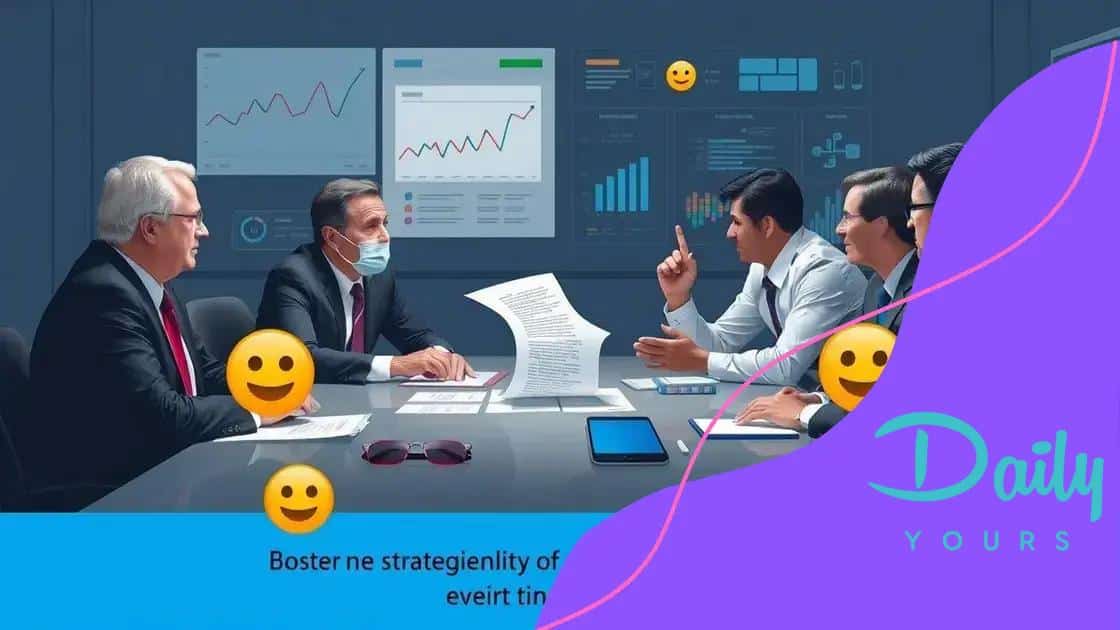Global disinformation control measures: how to combat misinformation

Anúncios
Global disinformation control measures involve technology, community initiatives, and government policies designed to identify and combat false information, promoting integrity in the information shared with the public.
Global disinformation control measures are becoming increasingly vital in our connected world. As misinformation spreads at an alarming rate, we must explore practical strategies and initiatives designed to combat it.
Anúncios
Understanding disinformation and its impact
Understanding disinformation is crucial in today’s world where information spreads rapidly. Disinformation can lead to negative consequences, shaping public opinion and influencing behavior.
What is disinformation?
Disinformation refers to false or misleading information intentionally spread to deceive others. It can take many forms, including fake news, manipulated images, and misleading statistics. With the rise of social media, the spread of disinformation has become easier and faster.
The impact of disinformation
Disinformation has severe impacts on society. It can:
Anúncios
- Distort political discourse by spreading false narratives.
- Influence public health decisions, especially during crises.
- Undermine trust in media and institutions.
When individuals consume disinformation, they may make poor decisions based on false beliefs. This influence can polarize communities and disrupt social harmony.
Furthermore, disinformation can also lead to violence, as seen in various global events where false information incited conflict. Understanding the pathways of disinformation is essential for developing effective strategies to combat it. By being aware of how disinformation operates, individuals can better protect themselves and their communities.
Education plays a critical role in mitigating the effects of disinformation. By teaching critical thinking and media literacy skills, we empower people to discern reliable information from misleading content.
The role of technology in controlling disinformation
The role of technology in controlling disinformation is significant and multifaceted. As the digital landscape evolves, so do the tools we have to combat false information effectively.
Advancements in AI and Machine Learning
Artificial Intelligence (AI) systems can identify patterns in disinformation, helping to flag false content before it spreads. These technologies analyze vast amounts of data to detect inconsistencies and evaluate the credibility of sources.
Fact-Checking Tools
Numerous fact-checking websites utilize technology to verify the accuracy of news stories. These tools empower users to quickly check claims and discern facts from fiction. Some popular fact-checking initiatives include:
- PolitiFact
- Snopes
- FactCheck.org
Every day, these platforms help curb the spread of disinformation by providing reliable information and context.
Social media companies also play a crucial role by investing in algorithms designed to combat disinformation. They can now restrict the visibility of misleading posts and promote verified content instead. This initiative helps create a healthier information ecosystem.
Additionally, machine learning algorithms continuously improve to adapt to new disinformation tactics. By identifying emerging trends in the spread of false information, these technologies can stay ahead of deceptive practices.
Engaging users in disinformation control has also become a focal point. Technology not only detects problems but educates users about recognizing misleading content. Workshops and interactive modules can help people learn how to verify information critically.
Case studies of successful disinformation control

Examining case studies of successful disinformation control provides valuable insights into effective strategies. These real-world examples show how various organizations and governments have tackled the challenge of misleading information.
Government Initiatives
In the wake of rising disinformation, many governments have launched initiatives aimed at combating false narratives. For instance, Finland has implemented a national curriculum that teaches media literacy in schools. This program focuses on equipping young people with skills to recognize disinformation and evaluate news sources critically.
Public-Private Partnerships
Successful efforts often combine the resources of public and private sectors. In 2020, various tech companies collaborated with fact-checkers and non-profit organizations to ensure that credible information was prioritized during the COVID-19 pandemic. These partnerships aided in filtering misleading claims and helped share accurate data on health measures.
Another noteworthy example is the collaboration between the EU and social media platforms. They launched the Code of Practice on disinformation, establishing guidelines for promoting transparency in advertising and improving the visibility of fact-checking efforts.
Community-based approaches have also shown success. In various countries, local organizations have created campaigns to educate the public about spotting disinformation. These initiatives empower individuals to make informed decisions, particularly in situations where misinformation can lead to serious consequences.
Using targeted social media campaigns, these community organizations effectively reached diverse populations, increasing engagement with verified information. They successfully debunked myths and provided resources for further education.
Government policies on information integrity
Government policies on information integrity play a vital role in countering disinformation and ensuring the public receives accurate information. These policies often set the framework for how information is shared and regulated across various platforms.
Regulatory Frameworks
Many countries have introduced laws that aim to hold platforms accountable for the content shared on their sites. For example, some governments require social media companies to promptly remove disinformation and provide transparency in advertising. This helps to create a more trustworthy online environment.
Promoting Media Literacy
Effective policies also promote media literacy among the population. By educating citizens on how to critically evaluate sources and recognize disinformation, governments can empower individuals to make informed decisions. Some key initiatives include:
- Educational programs in schools focusing on digital literacy.
- Public campaigns that provide tips on identifying fake news.
- Partnerships with non-profits to develop community resources.
These strategies significantly contribute to creating a well-informed public that can better navigate the complexities of information in the digital age.
In addition to regulatory measures, government agencies often collaborate with technology firms to develop tools that flag misleading content. This collaboration helps enhance the responsibilities of social media platforms and ensures they take an active role in curbing disinformation.
Another critical aspect of government policy is transparency in information dissemination. Policies that require platforms to label sources of information and disclose funding for campaigns foster accountability. When users know the origins of their information, they are less likely to fall victim to disinformation.
Community initiatives against misinformation
Community initiatives against misinformation play an essential role in fostering awareness and understanding of accurate information. These local efforts help build resilience against false narratives and empower individuals to make informed decisions.
Grassroots Campaigns
Many communities have launched grassroots campaigns to combat misinformation. These campaigns often focus on educational outreach, raising awareness about the importance of verifying information before sharing. Volunteers in local organizations conduct workshops and seminars to teach residents how to identify false claims and trustworthy sources.
Collaboration with Local Media
Another effective approach is the collaboration between community groups and local media. This partnership helps to create fact-based content that addresses prevalent myths or misconceptions. Through articles, podcasts, or video segments, communities can directly engage with their audience and provide reliable information. Some highlights of these collaborations include:
- Production of public service announcements.
- Regular columns in local newspapers debunking common myths.
- Community events featuring experts discussing current issues.
These initiatives ensure that residents have access to accurate information tailored to their specific contexts.
Many communities also harness social media platforms to raise awareness about misinformation. They create dedicated pages and groups aimed at sharing verified news, encouraging discussions, and debunking false claims. Engaging members through interactive content helps foster a community-focused approach to information integrity.
By focusing on local experiences, these initiatives can address specific areas where misinformation is prevalent. For example, during an election cycle, communities can provide resources on candidates and policies that counteract misleading narratives.
FAQ – Frequently Asked Questions about Disinformation Control Measures
What are disinformation control measures?
Disinformation control measures are strategies and policies designed to identify, combat, and prevent the spread of false or misleading information.
How can technology help in controlling disinformation?
Technology, such as AI and machine learning, can analyze data patterns to detect disinformation quickly, helping to filter and flag misleading content.
What role do community initiatives play in fighting misinformation?
Community initiatives promote awareness and education, allowing individuals to recognize and challenge misinformation in their local environments.
Why is media literacy important for combating disinformation?
Media literacy equips individuals with the skills to critically evaluate sources and claims, making it easier to identify false information.





